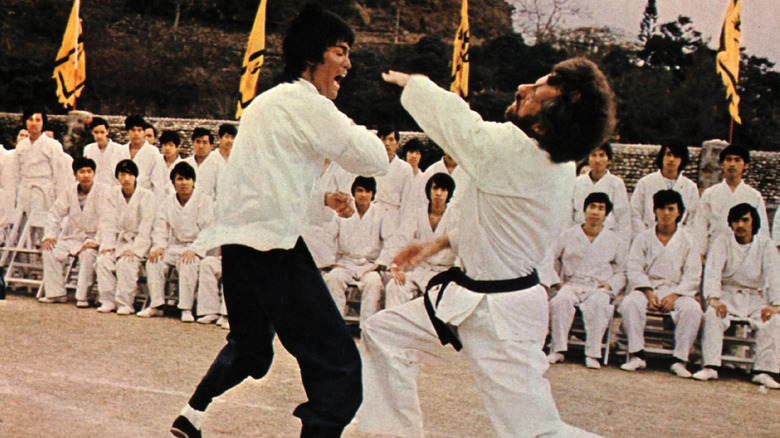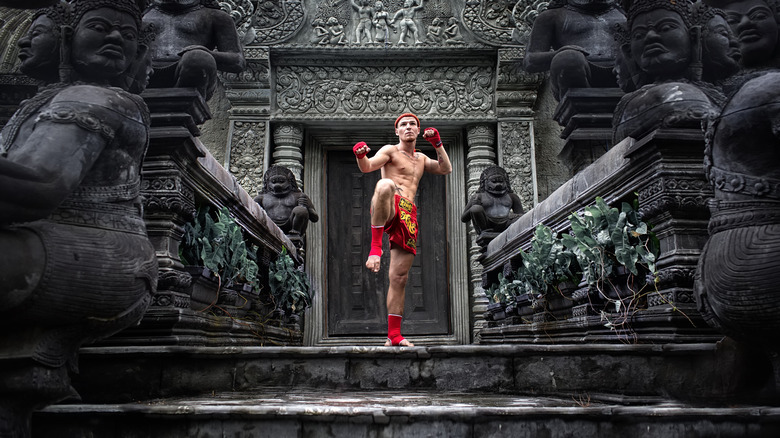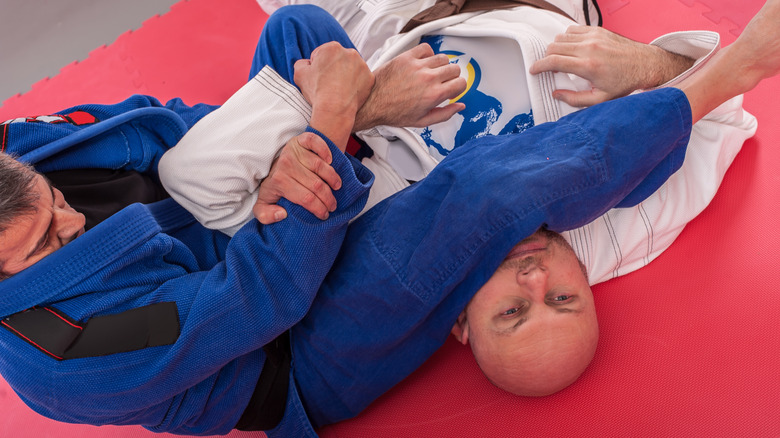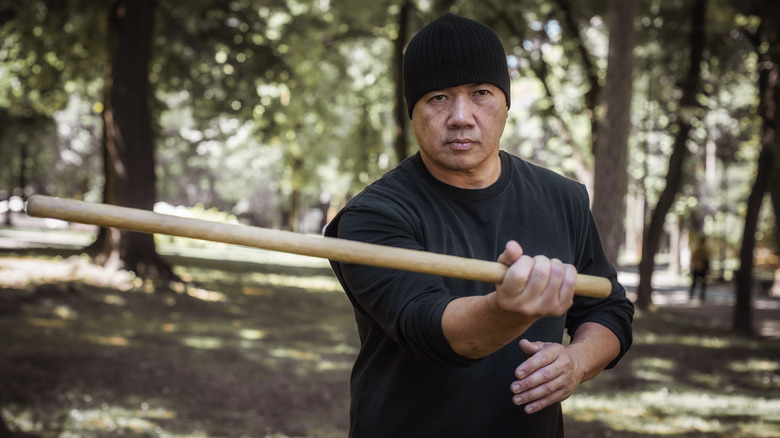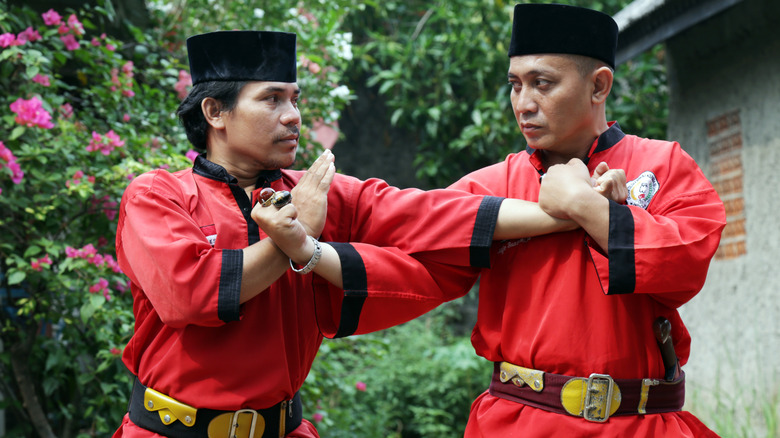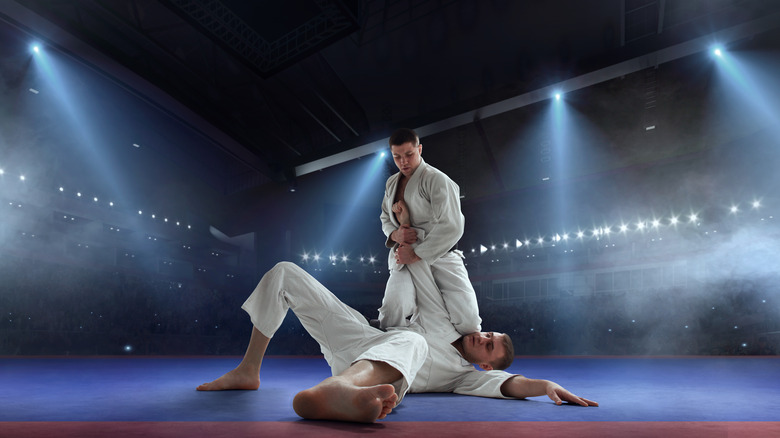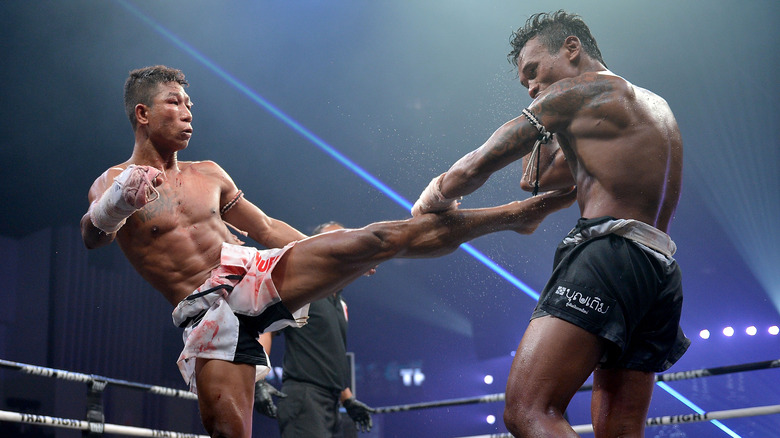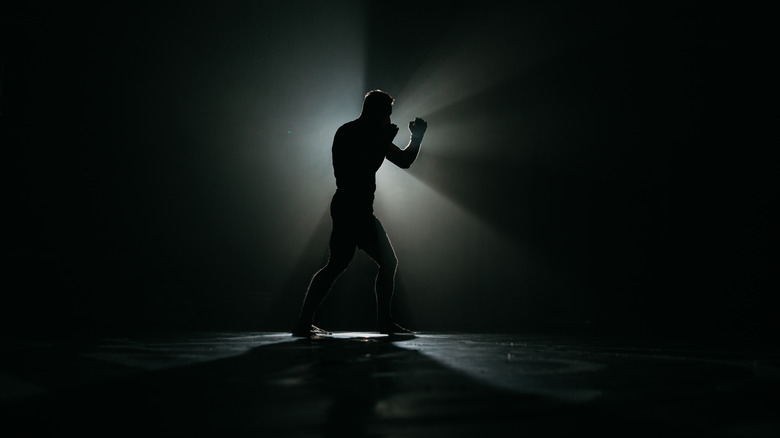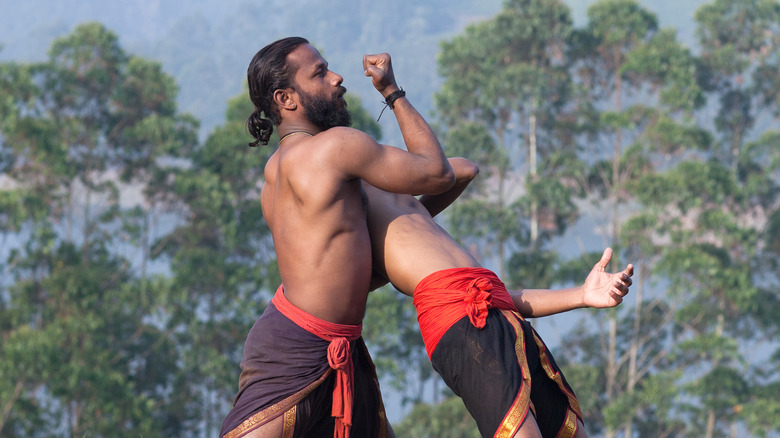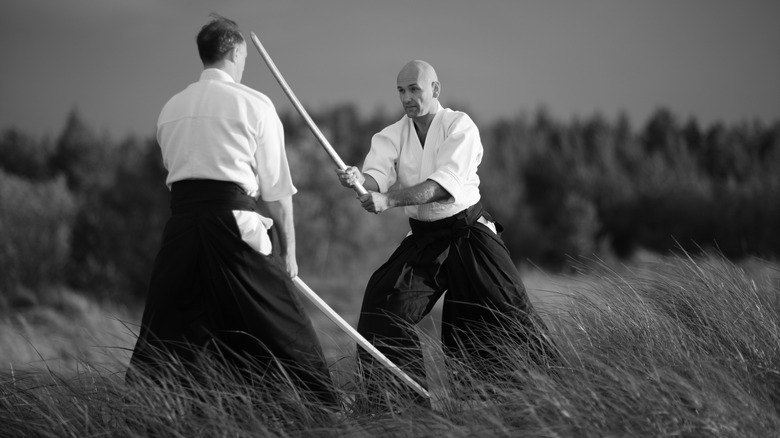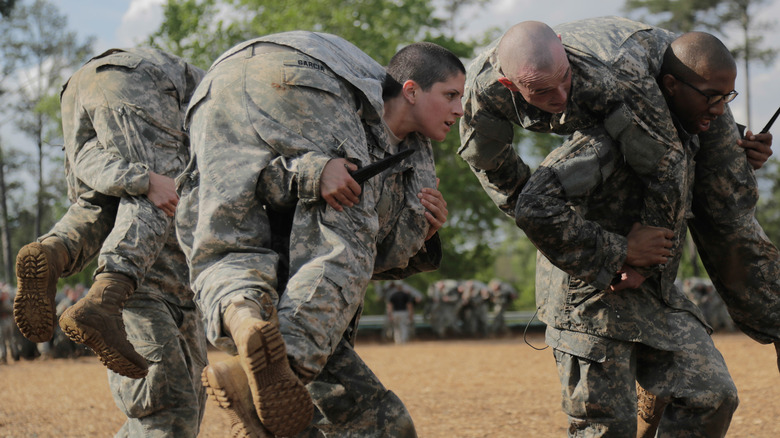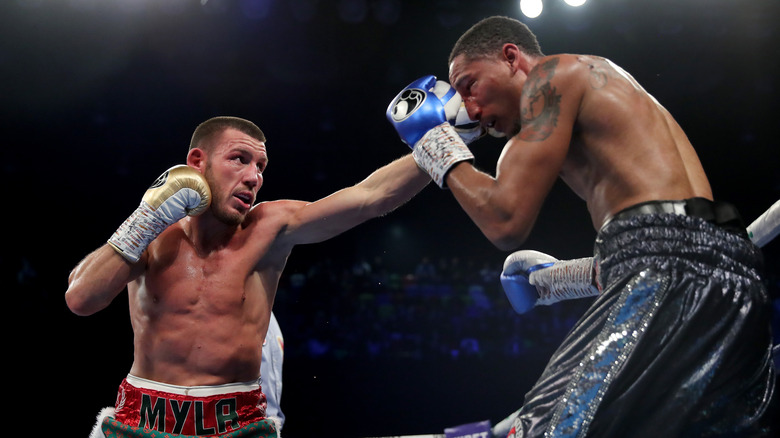The Most Dangerous Martial Arts In The World
While historically people trained in martial arts solely for self-defense purposes and to stay alive on the battlefield, these days participants often practice Karate, Tae kwon do, Judo, and other styles for other reasons, including exercise and competition, according to Level 3 Martial Arts Performance. People also choose to take a martial arts class to build confidence, release stress, and meet new people. Some arts have evolved heavily into sporting activities with less emphasis on self-defense application, reports Britannica. Others are effective as self-defense systems and are simultaneously used for entertainment purposes.
Today, there are several styles that stay true to their roots and continue to rely heavily on combative instruction. These martial arts may be considered more "dangerous" than others because the training and techniques are designed specifically to defend against an attacker and take down or submit an opponent. Some techniques are even lethal, depending on how they're executed. Some of these arts are toned down for the ring and are showcased in competitions around the world. They are structured so the opponent and attacker use some form of restraint and must comply with a certain set of rules.
If you're looking for a martial art that has serious self-defense applications, here are some of the most dangerous martial arts in the world.
Muay Thai Effectively Uses Punches, Kicks, Elbows, and Knees
Muay Thai, or "The Art of Eight Limbs," has its roots in Thailand. During the 14th century, the Burmese attacked Ayudhaya, Siam's capital city in Thailand, and looted the temples and other facilities. As a result, much of Muay Thai's written documents were wiped out, according to Tiger Muay Thai. So while the history may be a little muddy, it's known that the art focuses on eight contact points on the body, and the techniques were developed to imitate weapons.
For example, the hands act as bladed swords or daggers, while the shins and forearms are hardened to act as armor against attacks. Elbows are trained to act as a hammer or mace, and the legs and knees mimic the actions of an axe or staff. All of these body parts work in conjunction to take down an enemy. The art heavily relies on striking, but it also includes throwing techniques, locks, and occasionally submissions, reports Evolve MMA.
Today, the art has evolved into a sport, but that doesn't mean it isn't dangerous. Fighters usually have short careers. They are subjected to a lot of injuries, including sprains, bruises, pulled neck muscles, shin splints, torn ACLs, and concussions, according to Muay Thai Pros. It's dangerous to both be on the receiving end of a Muay Thai attack and to be a Muay Thai practitioner due to the stress the body endures while training and competing.
Brazilian Jiu Jitsu Focuses Largely on Submission
These days, you'll see Brazilian Jiu Jitsu (BJJ) heavily represented in mixed martial arts (MMA) bouts, including the UFC. These events are regulated, and competitors often aim to submit their opponents until they give up. While it may seem like it, the goal is not to unleash as much pain as possible. Still, the techniques that these men and women learn can be dangerous if applied with enough force and with a lack of control.
In 2015, a 32-year-old man named Napoleao José Alves died after an opponent used a rear naked choke on him during a training session, according to BJJ Eastern Europe. He didn't go to the hospital until two days later because the injury didn't seem that bad. However, a few days later doctors pronounced him brain dead. He suffered a cerebral ischemia, according to the death certificate, which occurs when there is decreased blood flow, which can affect brain function and lead to a stroke.
This type of incident is rare, however. If you Google Brazilian Jiu Jitsu deaths, you'll find material, including articles by BJJ Tribes, which points out that BJJ-related deaths and concussions are uncommon due to the lack of striking in the art. BJJ does involves chokes, but practitioners usually tap out before they go unconscious. Still, if applied with force and intent, this type of submission can be deadly.
Kali Uses Stick and Knife Attacks
The Filipino martial art known as Kali, Arnis, or Escrima/Eskrima was originally used to protect citizens from foreign invaders and to safeguard one's family, land, and belongings. It is a family art that has been passed down over the generations, according to Inquirer, and in years past outsiders were not allowed to learn it. That has changed over time, and today you will find many non-Filipinos studying the art. Kali involves striking, grappling, and take downs. However, it is most often recognized for its use of sticks and bladed weapons.
Kali is a well-rounded and versatile art that works effectively in a variety of self-defense situations. A stick or sword can be used for long-range, mid-range, and short-range attacks. You can use the tip, body, and bottom of a stick, sword, or bladed weapon to defeat an opponent, according to Black Belt.
Still not convinced? If you learn Kali, you learn how to handle hand-to-hand combat, hand-and-knife combat, knife-and-knife combat, and much more, which you can read in detail in the book "Eskrima Self Defense: Practical Techniques for Dangerous Situations." Since many martial arts focus largely on open-hand defense with little to no real-world weapons training, this puts Kali on another level.
Pencak Silat Uses Weapons and Is Very Versatile
The Indonesian martial art Pencak Silat/Pentjak Silat incorporates hundreds of styles, according to Black Belt, and is prevalent in Indonesia, Malaysia, Singapore, Thailand, and the Philippines. There are also a few schools in the United States, but they are few and far between. While they may be slightly different, they all concentrate on combat application and the use of weapons.
The system incorporates close-range movements using the knees, elbows, and head. Practitioners aim for vulnerable targets, such as the groin and eyes. They learn throws, strikes, and grabs. One particularly brutal throw involves controlling an opponent's head, jumping through the air, yanking the enemy down to the ground, and kneeing them in the spine. Some styles use nerve strikes, while others control their opponents using their sarong for leverage. It's a very versatile system that allows fighters to build an arsenal of techniques that works for them.
Silat practitioners often know how to use one or more of the following weapons — a knife, stick, sword, staff, spear, rope, chain, whip, or projectile weapons. One weapon, the karambit, thrusts upward in a motion that can destroy an enemy's bowels. These fighters use fast, low kicks, and they learn "finishing" techniques, (a throw, takedown, lock, choke) to end the attack.
Hapkido Practitioners Master Many Skills
Hapkido is a defensive martial art with South Korean roots, and its goal is to reduce the advantage of opponents who are larger and stronger, according to master David Barney Jr., who spoke to Your Home Security Watch. The art encompasses a lot of different skills, including joint manipulation, grappling, kickboxing, throws, and weapons, making it an all-encompassing art with a lot of skills to master.
The art is so effective that Grand Master John Pellegrini teaches the style to military personnel and law-enforcement officers, according to Black Belt Magazine. He told the publication that his style emphasizes "close-quarters conflicts for modern battlefield environments." He explained, "We take into account that when [a soldier] strikes, joint-locks or takes somebody down, he's going to have equipment on."
Instead of kicking to the head or throwing jumping and spinning kicks that require a little bit of space, Hapkido practitioners focus on skills that work in close-quarter situations. "We teach a combination of techniques, like low-line kicking, strikes with the hands and joint-locking with the possible application of pressure points." He added that hand strikes to the head are common because they rattle and stun an enemy and can affect their vision. This in turn gives the practitioner an advantage.
Lethwei Fighters Are Known for Brutal Headbutts
Lethwei is also known as Burmese bareknuckle fighting. The art was developed in Myanmar hundreds of years ago and was used against enemies from nearby countries, according to Tomislav Zivanovic, a mixed martial arts analyst. Like many martial arts, it eventually turned into a spectator sport, but many early matches were brutal and involved a lot of blood shed. That's because the competitors didn't wear any protective gear, and there were no rules. As a result, fighters often got severely injured, and some even died. Even today participants forego gloves and shin guards when competing. This makes it dangerous for both fighters.
The art remained under the radar for generations until three American kickboxers visited Myanmar in 2001 to train with and compete against Lethwei practitioners. All three Americans were knocked out in the first round of their matches. Lethwei techniques include punches, kicks, knee strikes, elbow strikes, sweeps, throws, and takedowns. But the most devastating is the headbutt, which can cause extreme pain, injury, and possibly even long-term damage. For these reasons, headbutts are banned from mixed martial arts (MMA) matches.
Today, some fighters still train using traditional methods, and the only way to win is with a knock out. To train for these bouts, competitors condition their entire bodies and are extremely fit.
Ryukyu Kempo Focuses on the Nervous and Circulatory Systems
Ryukyu Kempo was developed in Okinawa and involves close-quarters striking, blocking, grappling, locks, and escape techniques, according to Multi-Style Martial Arts. It also strongly emphasizes the use of pressure points, which allow practitioners to efficiently stun an opponent's nervous system — this is particularly effective if the person is stronger and more aggressive. The art focuses on techniques that can save your life, regardless of how small or large you are. This makes it a formidable art compared to those that may rely on strength to gain the upper hand.
Ryukyu Kempo also incorporates grappling as well as joint manipulation, which helps when an individual is faced with common attacks, such as grabbing. The art uses strikes that attack the nervous and circulatory systems, which can disable an enemy for a short period of time, preventing him or her from fighting back. Those who practice the art are taught conditioning exercises and to hone their reflexes so they're ready when and if the need arises. According to East Valley Martial Arts, it is taught in an A-Z fashion in which each step builds on to the last.
Kalaripayattu Practitioners Attack the Joints and Arteries
The Indian art of Kalaripayattu mimics the motions of birds and animals, according to Forbes India. Many years ago when the kings of Kerala were involved in a conflict, a warrior from each side was picked to fight for their leader. It was an honor to be chosen for this task, and the men fought to the death. Interestingly, students are simultaneously taught restraint and meditation when practicing this art today. They only use it to defend others and not in an offensive way. Most students don't even learn the art's most dangerous techniques.
Practitioners are taught the weakest points on the body, which consist of joints and arteries. If properly applied, these techniques can cause extreme pain, injury, and possibly death. The same points can be used for an opposite reaction — rejuvenation. It takes several years to become skilled in Kalaripayattu. One practitioner told Forbes India that he knew how to kill someone by striking a certain spot in an opponent's chest. He had also heard a story about an individual being struck on this same spot by a wooden weapon. He allegedly died before he reached the hospital. However, there is no recorded information about this incident.
Sword Arts Take Years To Master
Today, many students practice swordsmanship. They may participate in popular Japanese styles such as Kendo, Kenjutsu, Fencing, and Iado, or Chinese sword arts. In ancient times, these arts were for combative purposes, according to KIAI, the international association of Japanese sword arts instructors and teachers. These skills were used on the battlefield during war. These days, the majority of practitioners study these arts for recreation and not for self-defense purposes. However, a sword-wielding hobbyist could still inflict some damage on an unsuspecting individual (or even one that sees the attack coming).
A school like Imperial Combat Arts in Denver, Colorado, conducts combat-level sword training that has roots in the battlefield. It teaches these skills in conjunction with hand-to-hand practice, ground fighting, and Chinese chin na (joint locks). Students learn how to use a knife, gun, and club among other weapons. The instructors emphasize that it can take years of training to become proficient.
The website notes, "Through this rigorous and fully immersive study practitioners today can become just as powerful and effective in melee combat as our warriors and champions of old."
The LINE System Was Developed by a Marine
A man named Ron Donvito developed a close-quarters combat system known as the LINE System prior to joining the U.S. Marine Corps in 1978. The system was developed for entry-level combatants regardless of age or gender, making it accessible to everyone. During an interview with Fight Times magazine, Donvito explained that the system incorporates grabs, chokes, and headlocks along with punches and kicks. It also teaches attacks and defense with edged or other weapons among other skills.
About 750,000 military personnel worldwide have had some exposure to the LINE System. Donvito explained that his combat system is meant to be all encompassing, and it covers "all forms of basic close combat from standing to on the ground both armed and unarmed." He bases his teachings on science, medical data, and research to ensure that the skills are effective in real-world situations. For example, he explained how you can simply do a knee strike to a man's face, but if you hold his head, pull it towards your knee, and then strike, the technique "becomes probable for success."
He emphasized that entry-level practitioners still need to learn basic skills that will protect them until they have enough practice to learn the higher levels in the system.
Boxing Can Cause Significant Brain and Eye Injuries
While many people believe that mixed martial arts is bloodier and more violent than boxing, you're more likely to sustain serious injuries in the latter, according to research from the University of Alberta, as reported by Eureka Alert. Researchers examined 10 years worth of data and determined that while MMA practitioners sustain more minor injuries, boxers are more likely to experience concussions and other types of head trauma, as well as eye injuries and broken bones, which are much more devastating.
Modern boxing got its start in the U.S. and United Kingdom in the late 19th and early 20th centuries, according to How They Play. Some doctors believe boxing should be banned due to the eye and brain injuries that are sustained by repeated impacts. While these types of injuries may seem insignificant when they're first sustained, they can cause serious issues down the line.
The world's most famous boxer, Muhammad Ali, estimated he had received 29,000 blows to the head during his career, according to Brain & Life. The sport causes neurologic trauma, such as confusion, an unsteady gait, and slowed movements, which have been attributed to "multiple subconcussive impacts to the head — that is, injuries that don't cause symptoms but cause cumulative damage."
Ali brought attention to the long-term effects of repetitive impacts to the head, including chronic traumatic encephalopathy (CTE), which affects mood, judgment, impulse control, depression, parkinsonism, memory, and dementia and also affects football players. These symptoms can occur years after the boxer stops boxing.
